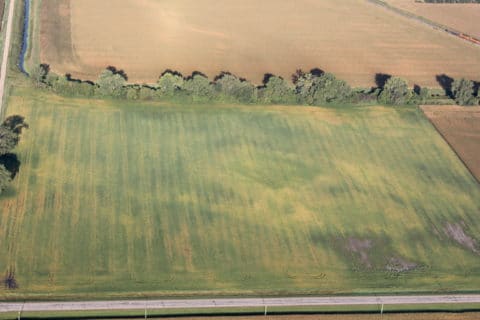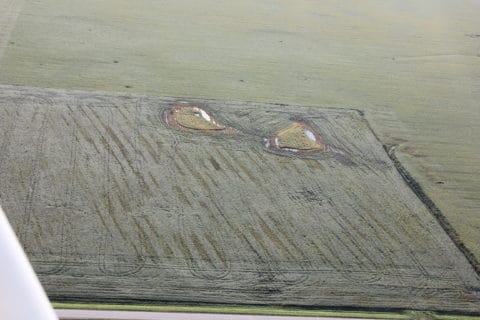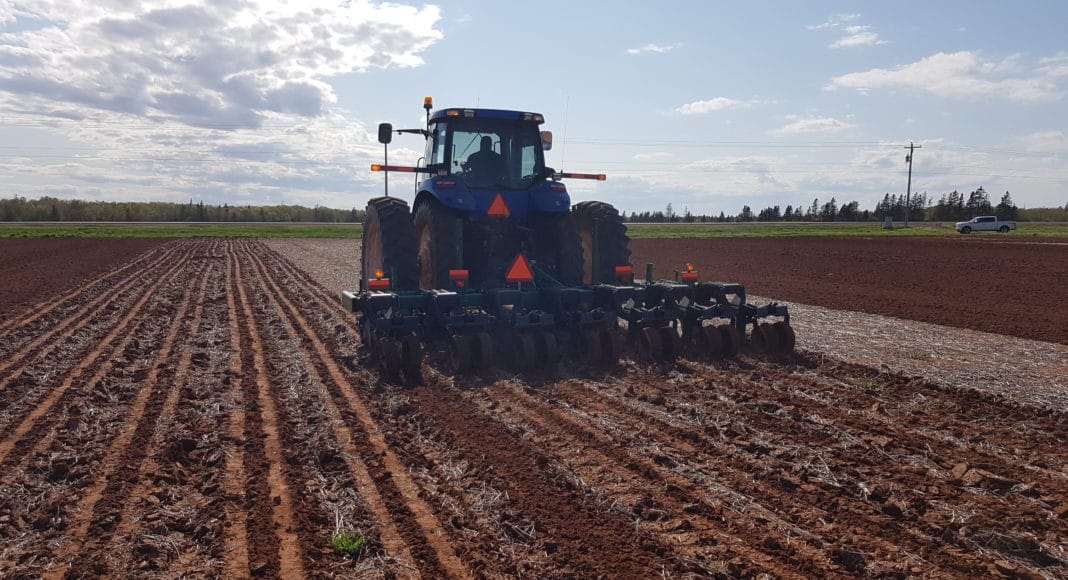[deck]Four experts review the causes and negative aspects of soil compaction and provide their newest strategies to prevent and mitigate its effects.[/deck]

For this edition of Roundtable, Spud Smart sought input on new tactics and best practices from industry experts Jodi Dejong-Hughes, regional extension educator at the University of Minnesota; Ryan Barrett, research and agronomy co-ordinator at the P.E.I. Potato Board; Dan Sawatzky, manager at Keystone Potato Producers Association in Manitoba; and Matt Ramsay of Oyster Cove Farms in Prince Edward Island.
In simple terms, compaction can be described as the reduction of pore space in the soil — and how much compaction occurs as well as how much recovery from compaction is possible is affected by soil type. Kinds of compaction include surface compaction (especially under wheel tracks), plow or tillage pan compaction (just below plow depth) and deep/subsoil compaction.
“Compaction can cause several problems, many of them long term,” explains Jodi DeJong-Hughes. “It results in decreased plant growth because the plant has difficulty growing larger roots and this obviously curtails nutrient and water uptake. There can be less available water in compacted soil, but compacted soil that’s saturated can also lead to soil denitrification and reduced soil oxygen, which can, in turn, result in reduced root growth and nitrogen and potassium deficiency.”

Uneven planting depth and sidewall smearing is also common with compacted soil, reports DeJong-Hughes, as is an increased risk potential for erosion. Lastly, compacted soil can also increase risk of seedling disease.
Matt Ramsay says at Oyster Cove Farms they have stepped up their compaction investigation and management in recent years. “We’ve learned a lot about plasticity of soil and in many years we’ve had to start planting in conditions that weren’t ideal,” says Ramsay. “I think we, and the whole potato industry in P.E.I., are recognizing compaction as a cause of yield loss and something we need to prevent as much as possible. Soil structure hasn’t traditionally been considered very much, but that’s changing.”
Also, in Prince Edward Island, Ryan Barrett and his colleagues have been making mitigation of compaction a priority in extension efforts during the last couple of years. “It’s hard to know whether compaction is getting better or worse over time as we don’t really have long-term studies or surveys,” says Barrett.
“However, we do know that there are many fields in potato production in P.E.I. that struggle with it. We did some trial work from 2014 to 2016 looking at yield variability within fields and there were some indications from this work that compaction is having an impact.” He adds that during 2018 and 2019, harvest conditions were wet and growers have had to work hard to get their crops out of the ground before winter, so minimizing compaction often took a back seat.
The primary problem created by soil compaction in Prince Edward Island, in Barrett’s view, is reduced access to water, and with more than 90 per cent of potato production in that province non-irrigated, it’s a significant concern. “We seem to be experiencing drier summers here in P.E.I.,” he adds, “so this has a big impact on yield potential. In addition, I tend to see a higher percentage of misshapen tubers from highly-compacted soils. [The soils here] also make water infiltration difficult. As a result, we see more ‘ponding’ of water on compacted fields, which can result in more tuber rot and storage issues.” Compacted soils are slower to dry out in the spring, he adds, which delays planting and also limits yield potential.
In Manitoba, potatoes are grown in many types of soil, and Dan Sawatzky observes that although compaction is obviously a bigger concern in soils with greater clay or silt content, he and his colleagues have observed limited root growth and tuber formation in all soil types. In the experience of Sawatzky and his colleagues, compaction has been somewhat elusive to both measure and control. At the same time, he says “compaction is not generally considered one of the leading causes of overall yield loss. There can be specific instances where it becomes a greater concern following unfavourable conditions when traffic in fields occurs.” He adds irrigation is used extensively in Manitoba, and this may contribute to good water infiltration by minimizing the formation of dry hardpan.

HOW TO TEST
In the last couple of years, Barrett and his colleagues have been organizing presentations with speakers who encourage more testing to assess the extent of growers’ compaction issues. “It’s important for growers to use penetrometers to assess compaction themselves and then to dig some holes in their fields to verify if compaction layers exist,” says Barrett. “This spring, we initiated some trial work with growers to verify the depth of compaction layers in their fields.”
At Oyster Cove, the Ramsays have used a simple penetrometer built using a protocol created by Kensington North Watershed Association staff in collaboration with scientists at Agriculture and Agri-Food Canada. This simple device has been shown to provide results similar to the complex and more expensive penetrometers on the market.
In their own investigations of the extent of compaction in P.E.I. potato fields, Barrett and his team calculated the average penetrometer reading to be 200 psi at an 8-inch soil depth. This is a serious finding — that measurement corresponds to a potential root penetration of about 35 per cent. In terms of what type of compaction was observed, Barrett reports both surface compaction (with high soil bulk densities) as well as compaction layers (plow pans) in many fields.
Sawatzky says testing for compaction is “quite extensive” in Manitoba and most growers work with consultants who use mechanical probes for more consistent readings. “Findings reveal varying layers of resistance,” he explains, “and higher-traffic areas such as headlands tend to show the greatest issues.”
PREVENTION
There are multiple practices that can minimize compaction and its effects, and none of them are new. Effective prevention is a matter of using most, if not all, of the practices consistently. That means ensuring everyone on the farm is on board.
DECREASING EQUIPMENT WEIGHT
Many growers in Prince Edward Island, according to Barrett, are now using trucks/trailers with more axles to spread the load. “This takes effort to communicate to all equipment operators, but the benefits are real,” he says.
As well as decreasing axel weights, DeJong-Hughes advises reducing the overall weight of your equipment as much as you can. The Ramsays have already done this. They are now using smaller tractors in their fields (weighing about 15,000 pounds each) and have sold a piece of equipment that they felt was too heavy. “We still have a lot of three-point hitch equipment,” Ramsay adds, “and we’re still looking at ways to spread out the weight so that it’s not concentrated at the back.”
DeJong-Hughes also advises using bigger tires on field equipment and ensuring they are properly inflated (not overinflated).
TRAFFIC
There is still some degree of belief out there among growers that it’s better to spread out compaction, says DeJong-Hughes, but this is an absolute myth. Use “controlled traffic practices,” she advises, only driving in existing tracks.
Barrett reports many growers in Prince Edward Island are finding ways to decrease field traffic, reducing the number of tillage passes, and passes over the field by hilling at planting or putting seeder boxes on tillage equipment. Not only does this reduce the potential for compaction, but also saves time and money.
Last year, the Ramsays started planting and tilling only on tramlines, and they’ve also used a vertical tiller that goes down to 24 inches on tram lines in the fall, which did result in some increased yield the year after. “The benefits seem to be largely associated with creating hills, and we’re not sure what benefits we’re getting from the subsoil being tilled,” says Ramsay. “We need replicated split trials with vertical tillage and controlled traffic. It’s still early days in our understanding.”
ROTATION
It’s well known that employing rotation crops is a good practice to achieve many aims, including minimization of compaction, but Barrett warns that it takes good management — and in heavily-compacted fields, multiple years may be required to achieve significant improvements.
In Prince Edward Island, he and his colleagues have seen increased use of crops such as daikon radish, sorghum sudangrass, forage pearl millet and alfalfa, all of which produce deep, penetrating roots. “They are also generally associated with building soil organic matter, which also improves the structure of soil,” he says.
“Alfalfa generally requires a longer rotation of four to five years to get the maximum benefit from its deep, fibrous taproots. Sudangrass and pearl millet need to be mowed at least once to encourage root growth, aiding in compaction mitigation.”
Barrett and his team will be continuing field trials with a number of growers to help quantify the impact of these crops on soil health, soil compaction and marketable potato yield.
At Oyster Cove Farms, Ramsay says they have tried a lot of rotational crops such as mustard and buckwheat to determine what effect they will have on soil-borne disease and general soil health, but they are moving toward more perennial forages for the benefits of reduced tillage and to promote better soil structure.
In Manitoba, potato crop rotation generally includes rye, wheat, corn or soybeans, and a bit of alfalfa, with rotation decisions not generally addressing compaction concerns, but rather economic return, says Sawatzky. “Rye, canola and alfalfa tend to leave the soils a little looser than other row crop rotations,” he notes. “Mustard is used more for Verticillium control. Provincial soil extension work has been carried out over the past few years with daikon radishes to determine their effect on compaction. Radish, and to a lesser extent clover/mustard, has less effect on structural compaction, but has been shown to open up better water infiltration channels within the soil.”
RIPPING AND TILLAGE PRACTICES
While the crop management practices that prevent compaction mentioned above are most critical, farmers who wish to reverse damage already done can do some ripping up of compaction layers. However, the appropriate equipment is necessary. Barrett says deep tillage with straight shanks that reach two to three inches below the compaction layer in relatively dry soil conditions can help fracture the layers.
Last spring, after verifying the depth of compaction in various farmers’ fields, Barrett and his colleagues ran a ripper two to three inches below the identified compaction layer ahead of the potato planter. “This was the first year of this trial and we plan to repeat it in 2020,” he says. “There are also a number of growers that routinely do ripping [deep tillage] in the summer months in the year before potato planting to break up compaction layers. However, it’s important that this be done under relatively dry conditions, as ripping in wet conditions can cause smearing and make the problem worse.”
A number of P.E.I. potato growers, he adds, have replaced moldboard plowing with vertical tillage equipment (such as the Lemken Karat or Pottinger Synkro) associated with improved soil structure.
Sawatzky says in Manitoba, vertical and minimum till are extensively practiced, with attention also given to protecting overall soil health and replenishing organic matter. In addition, cover cropping is practiced on lighter soils prone to erosion, and some producers will incorporate deep ripping as part of their normal routine, he says.
Like Barrett, he warns mechanical tilling or deep ripping methods rely on the right soil moisture conditions to achieve the most effectiveness, and if not used correctly can result in establishing a hardpan deeper in the soil profile.
Sawatsky adds that many Manitoba growers will use a Dammer-Diker tool after planting to both loosen soil to a deeper depth and create pockets for moisture retention. Some do this as a standard practice each spring, ripping between rows and where hills will eventually be as well. Others use a ripper following planting with shanks penetrating beneath the seed.
LOOKING FORWARD
For the best results, DeJong-Hughes says all preventative practices need to be put in place to the greatest extent possible. She says most compaction, 80 per cent, happens on the first pass. She also warns “as much as is possible, do not till as tilling destroys soil structure. Build your soil structure. It’s your most important defence against future soil compaction.”
In Sawatzky’s mind, much remains to be learned about the effects of soil compaction on potato production in Manitoba. “A lot of compaction studies have dealt with other crops which have different root development patterns and may not relate directly to potato research,” he says. “We also see a range of penetrometer readings within the field, but we don’t know at what level of compaction potato yield is affected. With the thin margins of the potato industry, the cost-benefit of any change in cropping practice needs to be proven.”











